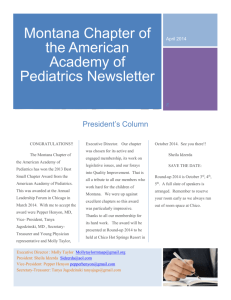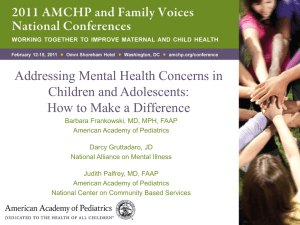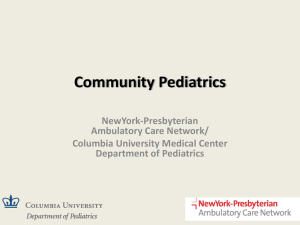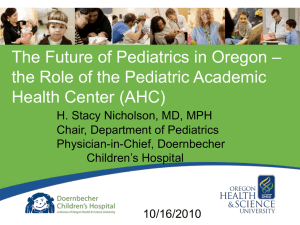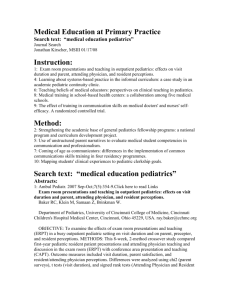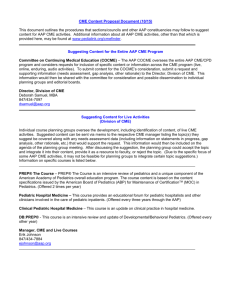Why Choose A Career in Pediatrics
advertisement
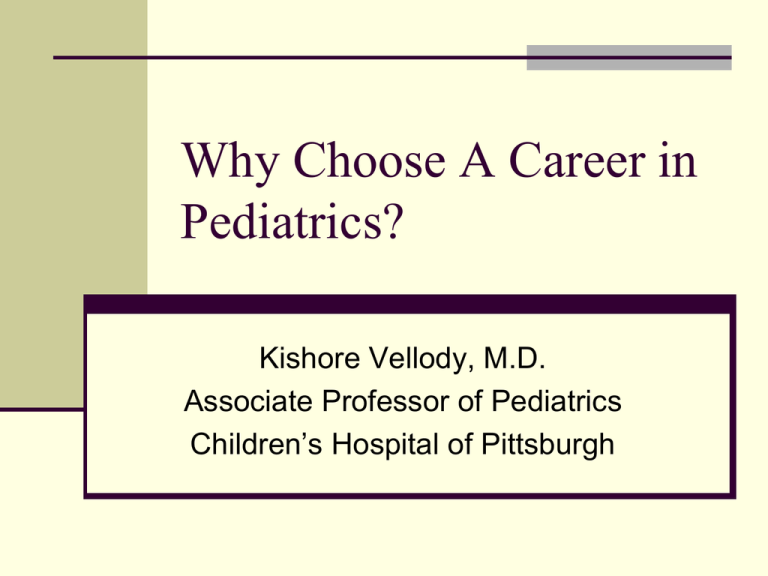
Why Choose A Career in Pediatrics? Kishore Vellody, M.D. Associate Professor of Pediatrics Children’s Hospital of Pittsburgh General Pediatrics - background Focus on the physical, mental, social health of children from birth to 21 years. Prevention, detection, and management of these issues Major advocates for children (i.e. health/safety policies, education) Why do we need Pediatricians? In other countries, pediatricians are specialists with general practitioners seeing most kids FP’s in U.S. are seeing less kids (2822% of FP visits) Care of children is becoming increasingly complex as we learn to diagnose and treat their illnesses more effectively 26.6% of kids have a chronic health condition AAP data, August 2013 What are the options? General Pediatrics Clinic Based Community Academic Hospital Based Community Academic General Pediatrics - Scope Health supervision Management of serious Anticipatory guidance and life-threatening illnesses Referral of complex conditions Consultative partnerships Community based activities (i.e. sports, schools, etc) Monitoring physical and psychosocial growth and development Diagnosis and treatment of acute and chronic disorders Job Satisfaction 94% of graduating pediatric residents state that they would choose pediatrics again if they had to do it all over. 2008 AAP Survey Data Job satisfaction survey of 6,600 physicians in 42 specialties. Four of the “top 10” were pediatric specialties: pediatric emergency medicine (#1), general pediatrics (#4), medpeds (#5),“other” pediatric subspecialties (#6), and neonatal-perinatal medicine (#7). Job Satisfaction Pediatricians rated higher satisfaction than internists in job, career, and specialty satisfaction General pediatricians more satisfied than all other physicians regarding their relationship with patients and personal time More likely to recommend their specialty to students seeking advice Shugerman, et. al. 2001, Leigh et. al. 2002 Job Opportunities 96% of pediatric residents secure a job before the conclusion of training. 84% of pediatric residents who completed training in the years 2006-2010 received an offer for their most desired general practice position. AAP Survey Job Opportunities Workforce shortages general pediatrics and subspecialties mean more job opportunities for graduates In 2010, 33% of general pediatric residency graduates planned on subspecializing Neonatal medicine Pediatric hematology-oncology Pediatric emergency medicine Pediatric cardiology Pediatric critical care. 6 Job Flexibility 38% of graduating residents apply for a part time position and 23% eventually accept one 29% of pediatricians (as opposed to 14% of all other specialties) have worked part time at some point in their career 8% of part time positions are males AAP August 2013 Multiple types of jobs offered ranging from part-time to more demanding hours Majority work in group practices Serving the Underserved Estimated that 52% of health care markets do not have a pediatrician Another 20% do not have a family practitioner ~ 650,000 children live in markets without a pediatrician or family practitioner 51 million people (1/5th) in the US lives in a rural area and only 10% of all U.S. physicians live there. 93% of those physicians say they plan to continue working in their practices long term Pediatrics Training 3 year training (201 programs avail.) Inpatient Outpatient clinic General and subspecialty exposure NICU, PICU ER 8123 Pediatric Residents nationwide >90% of first year pediatric residency positions fill each year AAP August 2013 Combined Peds/Adult Residency Training Pediatrics/Internal Medicine (4 yrs) Pediatrics/Derm (5 yrs) Pediatrics/ER (5 yrs) Pediatrics/Genetics (5 yrs) Pediatrics/PM&R (5 yrs) Pediatrics/Adult Psych/Peds Psych (5 yrs) Subspecialty Pediatrics Most require 2-3 years of post-residency fellowships Some require training in another discipline before becoming more focused on pediatrics such as: surgery, pathology, radiology Pediatric neurology, rheumatology, and psychiatry can be done with 2 years of general pediatric training followed by 2-3 years of fellowship Subspecialty Pediatrics Adolescent Medicine Allergy/Immunology Cardiology Clinical Genetics Critical Care Medicine Dermatology Developmental Emergency Medicine Endocrinology Gastroenterology Hematology/Oncology Infectious Disease Medical Toxicology Neonatology Nephrology Pulmonology Rheumatology Sports Medicine Research Those in subspecialties or in academic environments can choose between more research intensive goals or patient care/clinical goals or a combination of the two SOURCES http://www.aap.org/profed/career.htm http://www.aap.org/profed/Peds101book.pdf http://www.aap.org/profed/PEDS101charts.PDF Questions?

